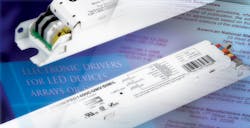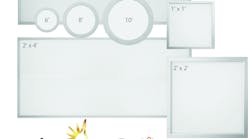JIANZHONG JIAO reports on ANSI efforts that will deliver driver testing standards commensurate with the standards the SSL industry has in place to test light-centric characteristics of lamps and luminaires.
The first LED lighting test standard (IES LM-79) was published in 2008 and since then, many related standard documents focused on testing have been developed or are currently in development by the IES (Illuminating Engineering Society), ANSI (American National Standards Institute), UL (Underwriters Laboratories), and NEMA (National Electrical Manufacturers Association). But the driver electronics in a solid-state lighting (SSL) product has been one area that lacked an accepted testing standard. Now ANSI has developed a standard for testing drivers that should allow SSL product developers to more accurately compare and specify drivers, ensuring robust system-level reliability and performance.
The earlier standard documents mentioned here cover LED components, subsystems (for example, an LED light engine), and lighting products including LED lamps and luminaires. Overall, these testing standards provide consistent and repeatable methods to test LED lighting product characteristics, how the characteristics change over time, robustness of an SSL design, and reliability.
Light testing
With guidance from these documents, manufacturers and users are able to evaluate LED lamp and luminaire performance per IES LM-79; LED package characteristics per IES LM-85; LED package luminous-flux maintenance and long-term projection per IES LM-80 and TM-21; LED lamp and luminaire luminous-flux maintenance and long-term projection per IES LM-84 and TM-28; and LED light engine lumen-output thermal dependence per IES LM-82. However, a major LED lighting component, the LED driver, has not been included in these widely-used testing standards.
LED drivers contribute to LED lighting performance and efficacy, as well as long-term changes and reliability. The lighting industry recognized the LED driver as a major component in the LED lighting product, as well as the need for standards to test its characteristics and long-term behavior. However, the industry has also faced challenges and engaged in long debates in regard to developing testing standards for LED drivers.
Much of the initial resistance to testing standards came from driver manufacturers who had extensive high-intensity discharge (HID) or fluorescent lamp ballast experience. In the early stages of test standard development, the argument was that drivers are simpler than ballasts; and electronic ballasts especially have been long-lasting — thus not requiring testing standards — so a standard for testing LED drivers was not necessary. Proposals for developing LED driver testing standards were brought to committee but did not receive sufficient support for further development.
Driver standard efforts
In 2009, when NEMA started developing LED driver performance standards as a design guideline (NEMA SSL1, Electronic Drivers for LED Devices, Arrays, or Systems, published in 2010), the testing section was drafted and later dropped. In 2011, LED driver testing standards were proposed again in IES, but the Testing Procedures Committee (TPC) concluded that drivers are not directly related to “light,” which means they are out of the scope of IES TPC for testing light, and the proposal was dropped.
Finally, in 2012, the same proposal that had been put before the IES TPC was presented to the ANSI ANSLG (American National Standard Lighting Group) SSL Working Group C82-04, the committee responsible for SSL drivers. At that time, many more LED drivers were deployed in the market, and their performance and reliability were quite diverse. It became in the best interest for both driver producers and users/product developers that a consistent test method be established.
In 2013, an ad hoc committee was formed in ANSLG C82-04 to draft the LED method of measurement standard and the committee arrived at a consensus for the scope of the document. The current scope states: “This standard describes the procedures to be followed and the precautions to be taken in measuring performance of LED drivers. Deviations from the procedures given in this standard are permissible for production or other testing provided that the methods used give the results in substantial agreement with the method given herein. In case of doubt, reference shall be made to the specified methods to establish the validity of the results obtained by any alternate procedure.”
ANSI ANSLG standard
This ANSI document allows for the identification of LED driver performance characteristics and will be of benefit to the SSL industry when it is implemented. Unlike the testing of LEDs or lamps and luminaires, where the output of these products is light and they can be characterized or measured, a driver’s output characteristic is the input to a load — LEDs or LED modules and arrays. The output of a driver is only measured electrically. In order to identify driver characteristics, the method of measurement — in particular, the parameters — must be well defined. To create consistency, this standard provides input measurement parameters as voltage, current, power, power factor, total harmonic distortion, and inrush current. Detailed descriptions for each of these input parameters are given in the document.
In today’s market, there are typically two types of LED drivers: constant-voltage (CV) regulated drivers and constant-current (CC) regulated drivers. CV drivers maintain a constant output voltage within specified limits even as their input voltage or output current varies within specified limits.
CV drivers can power multiple loads wired in parallel, provided that the sum of the load’s operating currents does not exceed the rated output current of the driver. For example, a CV driver rated at 24 VDC and 700 mA could drive one or two LED modules rated at 24 VDC and 350 mA.
CC drivers maintain a constant output current within specified limits even as their input voltage or load voltage varies within specified limits. CC drivers can power multiple loads wired in series, provided that the sum of the load’s operating voltages does not exceed the rated output voltage of the driver. For example, a CC driver rated at up to 24 VDC and 350 mA could drive one or two modules rated at up to 12 VDC and 350 mA.
Higher output voltages allow more LEDs or LED modules to be connected in series. Higher output currents allow more powerful LED modules to be used on a CC driver, or more modules to be wired in parallel on a CV driver. For both cases, a higher-voltage driver may be more efficient.
Voltage and efficiency
The efficiency associated with higher voltage is simply explained. Voltage and current regulators typically require a few volts of internal headroom voltage to operate. This voltage is not available to external loads, such as LED modules. The voltage drop across the regulator is a smaller percentage of the output voltage in higher-voltage drivers, so they tend to be more efficient than lower-voltage drivers. Some drivers may have multiple outputs — for example, two 24-VDC outputs or four 350-mA outputs — to drive multiple LED modules.
In each case, the ANSI standard provides testing procedures for measuring LED driver output parameters as output power, driver efficiency, driver case temperature, starting time, and run-up time. For CV drivers, the voltage output is critical, thus the measurement parameters should be RMS voltage, maximum and minimum peak voltage, and voltage ripple, as well as the corresponding RMS current. Conversely for CC drivers, the current output is critical; then the measurement parameters should be RMS current, maximum and minimum peak current, and current ripple, as well as the corresponding RMS voltage. In all the above measurements, load condition is important as well and the ANSI standard specifies that, in general, the driver shall be tested per the nominal load as described by the manufacturer.
This ANSI standard is an educational tool, and it is also a large step toward obtaining authentic and consistent driver performance information for SSL product developers. With the establishment of this document, the SSL community is one step closer to completing testing standards. Because LED drivers last a long time, the long-term changes — or reliability and robustness — should be tested as well. For this reason, ANSI is also developing LED driver robustness test standards. Stay tuned for the update.
DR. JIANZHONG JIAO, Director of Regulations and Emerging Technologies at OSRAM Opto Semiconductors, Inc., is an internationally recognized lighting expert. He has been actively involved in LED and SSL standard development activities. He serves as the past Chairman of the SAE Lighting Committee, past Chairman of NGLIA, past Chairman of the NEMA SSL Technical Committee, active member of IESNA Testing Procedure Committee, Roadway Lighting Committee, and Computer Committee, ANSI SSL Working Groups, Standard Technical Panel of UL8750, standard committees in IEEE, CIE USA, SEMI, JEDEC and other organizations. He can be reached at [email protected].






